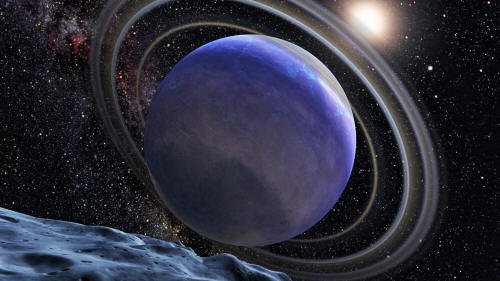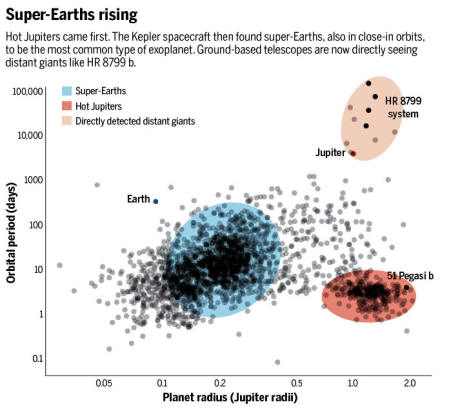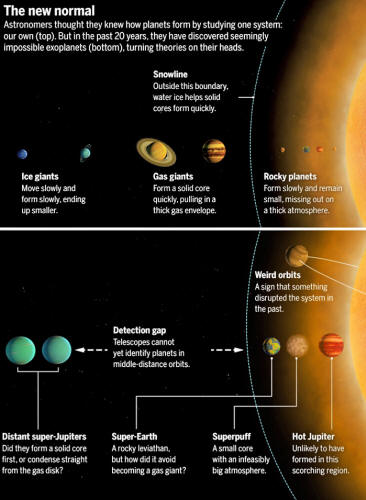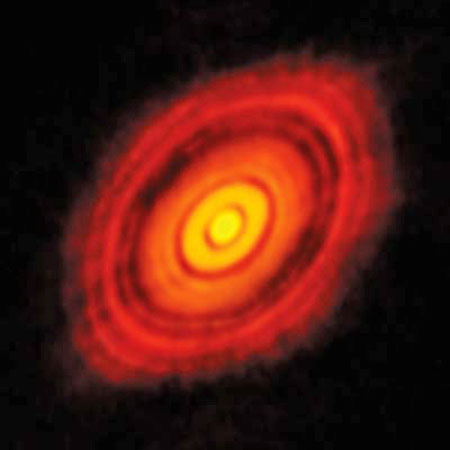|
a super-Jupiter (seen from a speculative moon),
takes 460 years to
orbit its star.
has turned planet formation theory
upside down.
The planet, 51 Pegasi b, was half as massive as Jupiter, but its 4-day orbit was impossibly close to the star, far smaller than the 88-day orbit of Mercury. Theorists who study planet formation could see no way for a planet that big to grow in such tight confines around a newborn star.
It could have been a freak, but soon, more "hot Jupiters" turned up in planet searches, and they were joined by other oddities:
The planet hunt accelerated with the launch of NASA's Kepler spacecraft in 2009, and the 2500 worlds it has discovered added statistical heft to the study of exoplanets - and yet more confusion.
Kepler found that the most common type of planet in the galaxy is something between the size of Earth and Neptune - a "super-Earth," which has no parallel in our solar system and was thought to be almost impossible to make.
Now, ground-based telescopes are gathering light directly from exoplanets, rather than detecting their presence indirectly as Kepler does, and they, too, are turning up anomalies.
They have found giant planets several times the mass of Jupiter, orbiting their star at more than twice the distance Neptune is from the sun - another region where theorists thought it was impossible to grow large planets.
Other planetary systems looked nothing like our orderly solar system, challenging the well-worn theories that had been developed to explain it.
Theorists are trying to catch up - coming up with scenarios for growing previously forbidden kinds of planets, in places once thought off-limits.
They are envisioning how planets could form in much more mobile and chaotic environments than they ever pictured before, where nascent planets drift from wide to narrow orbits or get ricocheted into elongated or off-kilter paths by other planets or passing stars.
But the ever-expanding zoo of exotic planets that observers are tallying means every new model is provisional.
THE TRADITIONAL MODEL
THE TRADITIONAL MODEL of how stars and their planets form dates back to the 18th century, when scientists proposed that a slowly rotating cloud of dust and gas could collapse under its own gravity.
Most of the material forms a ball that ignites into a star when its core gets dense and hot enough. Gravity and angular momentum herd the leftover material around the proto-star into a flat disk. Dust is key to transforming this disk into a set of planets.
The dust, which accounts for a small fraction of the disk's mass, is made up of microscopic specks of iron and other solids. As they swirl in the roiling disk, the specks occasionally collide and stick together by electromagnetic forces.
Over a few million years, the dust builds up into grains, pebbles, boulders, and, eventually, kilometer-wide planetesimals.
By the time that happens in the inner
part of the disk, most of its gas has been stripped away, either
gobbled up by the star or blown away by its
stellar wind. The dearth of gas
means inner planets remain largely rocky, with thin atmospheres.
They build up a solid core five to 10 times the mass of Earth - quickly enough that the disk remains gas-rich and the core can pull in a thick atmosphere, producing a gas giant like Jupiter.
(One of the goals of NASA's
Juno spacecraft, which arrived at
Jupiter earlier this month, is to see whether the planet really does
have a massive core.)
All the planets remain roughly where
they formed, in circular orbits in the same plane. Nice and tidy.
The inevitable conclusion was that it
must have formed farther out and moved in.
Another potential disruptor is a companion star in an elongated orbit. Most of the time it would be too far away to have an influence, but occasionally it could swing in and stir things up.
Or, if the parent star is a member of a tight-knit stellar cluster, a neighboring star might drift too close and wreak havoc.
KEPLER'S SURPRISING FINDING
KEPLER'S SURPRISING FINDING that 60% of sun-like stars are orbited by a super-Earth, however, requires a whole new class of theories.
Most super-Earths, thought to be largely solid rock and metal with modest amounts of gas, follow tighter orbits than Earth, and often a star has several. The Kepler-80 system, for example, has four super-Earths, all with orbits of 9 days or less.
The traditional theory holds that inside the snowline core accretion is too slow to produce something so large.
And super-Earths are rarely found in
resonant orbits, suggesting that they haven't migrated, but formed
where they sit.
One idea is to speed up accretion, through a process known as pebble accretion. The gas in a rich disk exerts a lot of drag on pebble-sized objects. This generally slows them down, causing them to drift in toward the star.
If they pass a planetesimal along the way, their slow speed means they can be captured more easily, boosting accretion.
But faster accretion and a gas-rich disk raise their own problem:
Eugene Chiang, an astronomer at UC Berkeley, says there is no need to speed up accretion, so long as the disk is solid-rich and gas-poor.
He says that an inner disk 10 times
denser than the one that formed the solar system could easily
produce one or more super-Earths. Chiang has his super-Earths avoid
collecting too much residual gas by forming in the dying days of the
disk when most of the gas has dissipated.
ALMA can map radio emissions from the warm dust and gravel in disks. The few it has studied so far seem to be relatively massive.
But the observations aren't yet a smoking gun, because ALMA is not yet fully operational and it can only see the outer parts of disks, not the regions where super-Earths reside.
Chiang also has an explanation for another discovery of Kepler's:
Such planets are thought to form in a gas-rich disk.
But in the inner disk, warm gas would
fight against the planet's weak gravity, so the cold and dense gas
of the outer disk is the more likely womb. Chiang invokes migration
to explain their close orbits - a notion supported by the fact that
superpuffs are often found locked in resonant orbits.
MOST OF THE ATTENTION
MOST OF THE ATTENTION in exoplanet research has so far focused on the inner parts of planetary systems, roughly within a distance equivalent to the orbit of Jupiter, for the simple reason that that's all existing detection methods can see.
The two main methods,
...both favor big planets in close orbits.
Imaging the planets themselves is
extremely difficult, because their faint light is all but swamped by
the glare from their star, which can be a billion times brighter.
Europe's Spectro-Polarimetric High-contrast Exoplanet REsearch (SPHERE) and the U.S.-backed Gemini Planet Imager (GPI) are attached to big telescopes in Chile and employ sophisticated masks, called coronagraphs, to block out the light of the star.
Not surprisingly, planets far from their
stars are the easiest targets.
What's most surprising is that all four are huge, more than five times the mass of Jupiter.
According to theory, planets in such
distant orbits move so slowly that they should grow at a glacial
rate and top out at masses well short of Jupiter's before the disk
disperses. Yet the planets' nice circular orbits suggest they
weren't flung there from closer to their stars.
This process requires a gas-rich protoplanetary disk, which breaks up into clumps under its own gravity. These blobs of gas would collapse over time directly into giant planets without having to form a solid core first.
Models suggest that the mechanism will only work in particular circumstances:
Can it explain the planets of HR 8799?
Only the outer two are distant and cold enough, Roman Rafikov says.
In the past, radio telescope observations of protoplanetary disks have provided some support for gravitational instability.
Sensitive to cold gas, the telescopes saw disks spattered with messy, asymmetrical blobs.
But recent images from ALMA paint a different picture.
Are planets forming
in the gaps?
ALMA is sensitive to shorter wavelengths that come from dust grains in the mid-plane of the disk, and its images of the star HL Tauri in 2014 and TW Hydrae this year showed smooth, symmetrical disks with dark circular "gaps" extending far beyond Neptune-like orbits (see picture, above).
These images, suggestive of planets
sweeping their orbits clean as they grow by core accretion, were a
blow to advocates of gravitational instability.
As a result, it is hard for theorists to get a full picture of what exoplanetary systems are like.
Astronomers won't have to wait long for better data.
Next year, NASA will launch its Transiting Exoplanet Survey Satellite (TESS), and the following year the European Space Agency (ESA) is expected to launch the Characterizing Exoplanets Satellite (CHEOPS).
Unlike Kepler, which surveyed a large number of stars in sparse detail to compile an exoplanetary census, TESS and CHEOPS will focus on bright, sunlike stars close to Earth, enabling researchers to explore the mid-orbit terra incognita.
And because the targeted stars are
nearby, ground-based telescopes should be able to assess the mass of
their planets, allowing researchers to calculate the planets'
density, indicating which are rocky or gassy.
For example, finding heavier elements in the atmospheres of super-Earths could suggest that a disk rich in such elements is needed to form planetary cores fast enough.
And next decade, spacecraft such as
NASA's Wide Field Infrared Survey Telescope and ESA's Planetary
Transits and Oscillations will join the hunt, alongside a new
generation of enormous ground-based telescopes with mirrors 30
meters across or more.
|





